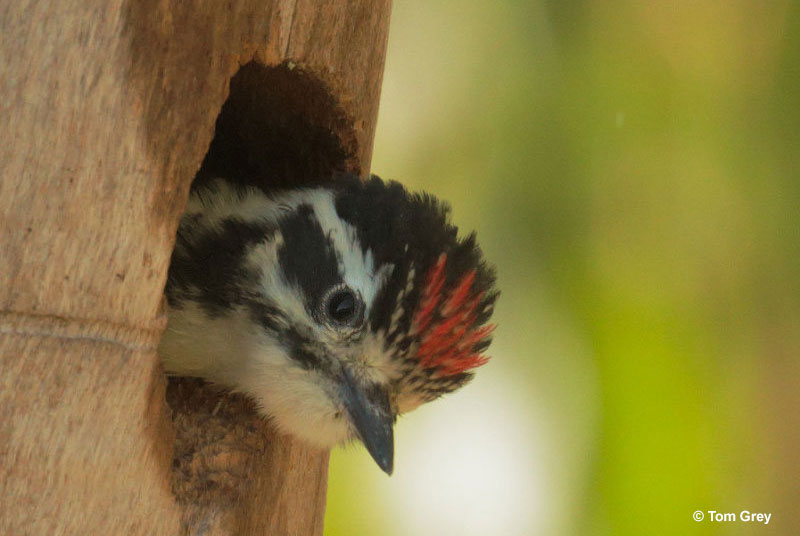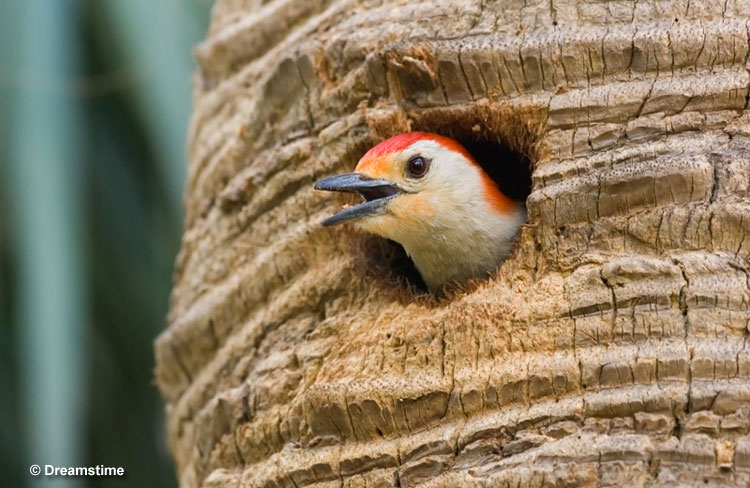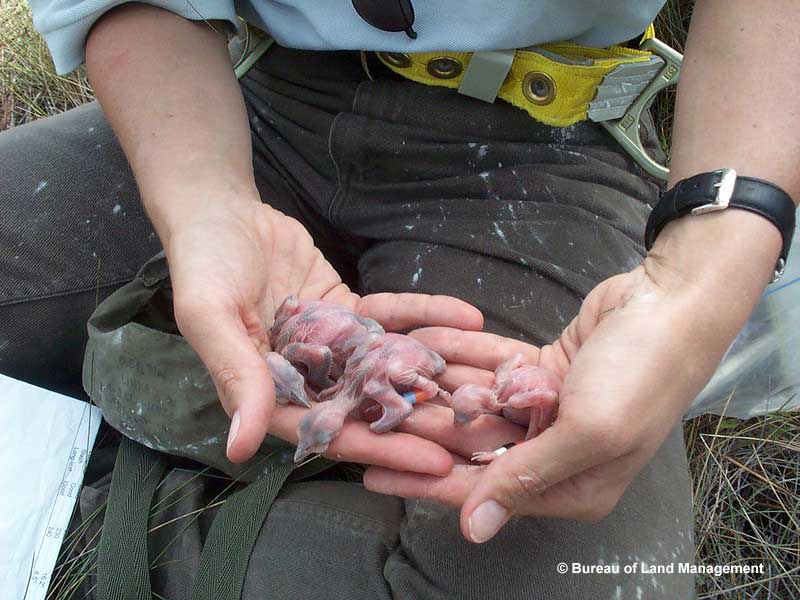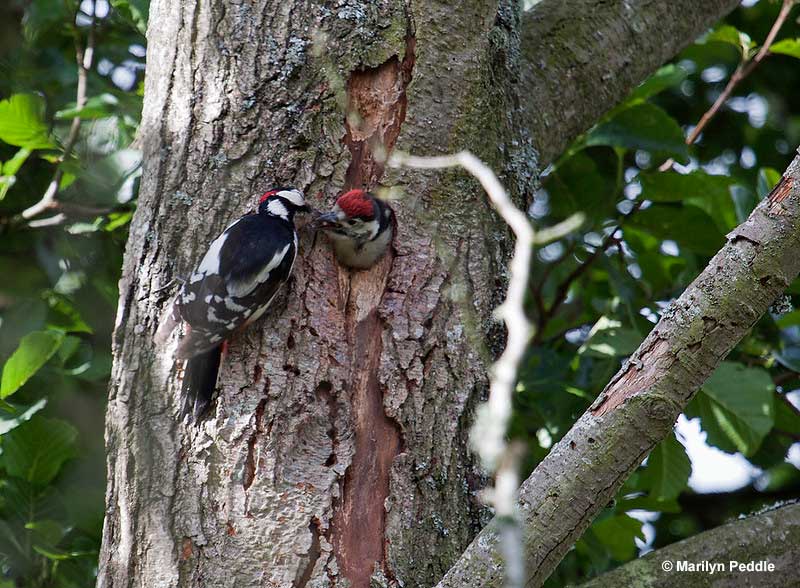
Baby woodpeckers remain unseen by us, but we can sometimes hear them screaming for food.
A part of the woodpeckers’ special charm is how they raise their young. Baby birds are usually quite different from their parents, and much of the bird species’ evolution revolved around the strategies of nurturing the precious chicks into adulthood. The same applies to woodpeckers.
What do woodpecker chicks look like? What makes them intriguing? Let’s learn more about the woodpecker nesting habits and the baby birds themselves.
On this page
The Woodpecker Nest
Woodpeckers are best known for creating nests in hollowed-out trees but also in structures such as telephone poles and even large cacti.
The nest building is where the pecking or drumming comes into the spotlight. With the ability to peck with an enormous force of 1000 G’s, it is no wonder that these living avian drills can excavate trees and wooden poles both horizontally and vertically with relative ease.
Since they’re woodcarving with their own heads, woodpeckers had to evolve elaborate anatomical protection (with the long and winding tongue playing an important role) to prevent brain concussions from banging with such strength.

Both sexes take turns in the nesting hollow’s excavation. They first excavate horizontally and then vertically. The finished hollow is often pear-shaped to make room for babies and can be up to 75 centimeters deep.
The parents rarely return to the same nest for consecutive years to avoid parasite infestations. However, other bird species also use old woodpecker holes for nesting.
The Wryneck Exception
The Wrynecks are a small genus containing only two species of slightly different woodpeckers. They are small, secretive, with distinct camouflage-brown plumage.
Not being able to drum and excavate tree holes, the Wrynecks use other species’ nesting cavities. If the hollow is already taken, they remove the original nester’s eggs or hatchlings and take over the spot.
Woodpecker Eggs and Incubation
Woodpeckers are generally excellent parents, especially regarding nest attendance. One of the New World’s largest woodpecker species, the Pileated Woodpecker, remains with their eggs for 99% of the incubation time.
Related: Baby Birds – From Hatching to Adulthood
An average woodpecker clutch features 3 to 10 eggs, white in color. Both parents incubate them, with females dominating during the day and males doing the night shift. The incubation lasts between 11 and 15 days.
Baby Woodpeckers
Baby woodpeckers are altricial, meaning they are born underdeveloped and helpless. They have disproportionately large, adult-like legs and bills. Their scarce feathers are in dark colors (black and brown), but gradually, they’ll start gaining adult-like color patterns.
At the hatchling and nestling stage, woodpecker chicks depend on their parents to feed and nurture them.
What Do Baby Woodpeckers Eat?
Baby woodpeckers’ diet is essentially the same as adults‘, consisting of small insects, nuts and seeds, small fruits, and tree sap. The composition of the diet can vary slightly depending on the woodpecker species.
Related: What do baby birds eat?
Besides providing them with juicy meals, parent woodpeckers also clean out their offspring’s fecal sacks. Woodpecker chicks actually defecate in the form of small packages that can be taken out of the nest.
While the chicks are tiny and unable to digest food fully, the parents eat the fecal sacks to retrieve the undigested nutrients.
As the chicks mature, parents pick up the sacks and drop them farther away from the nest.
It takes three to four weeks for woodpecker chicks to grow from helpless hatchlings to fledglings able to leave the nest.
How to Tell Baby Woodpeckers Apart?
Baby woodpeckers have a pretty distinct look – you can tell that a chick is some sort of a woodpecker. However, there are differences between individual species. By checking which woodpeckers live in your area, you can narrow down the choice between a few species and go from there.
Related: Types of Woodpeckers in North America
Like with many other birds, telling the difference between juvenile woodpeckers can be tricky, as some species can resemble others. For example, some juveniles have a temporary red cap larger than adults.
Baby Woodpecker – Frequently Asked Questions
What do baby woodpeckers look like?
Woodpecker babies are born naked, blind, and generally looking not much like their parents, save the long bills and strong legs. The first nestling plumage has dark colors.
Woodpecker chicks grow quickly and soon start looking more like their parents. However, their color patterns will remain different from adult birds for quite some time after fledging.
What time of year are baby woodpeckers born?
Woodpeckers lay eggs in spring or early summer. That means that the chicks hatch in spring or summer; the exact month varies from species to species.
How long do baby woodpeckers stay with their mother?
On average, young woodpeckers hang around with their parents for several months. It takes 3-4 weeks for baby woodpeckers to leave the nest. After that, the freshly-fledged juveniles often remain in close proximity to the nest and the parents for another few weeks. This strategy helps them gather enough strength and experience for an independent life in a safer environment.
Do baby woodpeckers have red on their head?
Most woodpecker chicks don’t have trademark red features on their heads. The Red-Headed Woodpecker’s chicks have dark colors throughout most of their early days. In the first few weeks of their juvenile phase, the fledglings’ cheeks start to flush red; from there, the namesake red color will spread to the rest of the head.
However, the Great Spotted Woodpecker juveniles are an interesting exception. The chicks hatch without the red markings, but by the time they fledge, juveniles actually have a larger red marking on the head than adults. In time, the red cap will be reduced to a red stretch on the back of the crown.
How do you identify a juvenile woodpecker?
You can identify a juvenile woodpecker by its drab coloration and messy-looking plumage. The immature birds look thinner and have uneven feathering. Pay attention to differing patterns in juvenile and adult birds.
What kind of trees do woodpeckers nest in?
The choice of a tree for nesting depends on the woodpecker species – in the simplest terms, it depends on what’s available in their native region.
People once thought that woodpeckers pick trees based on the trunk’s diameter. However, some studies have shown that woodpeckers can sense the density of the wood they’re pecking at and choose the trees that are likely the easiest to hollow out. Thus, wood hardness plays the greatest role in picking the nesting tree and the nest’s height. There seems to be no preference for a specific tree species.
Related: What to do if you find a baby bird
Famously, the desert-dwelling Gila Woodpecker creates nesting cavities in the giant Saguaro cacti. The thick cactus tissue provides excellent insulation for the chicks in the harsh desert climate.



gtm mail
Saturday 16th of December 2023
I truly appreciate your technique of writing a blog. I added it to my bookmark site list and will
Katarina Samurovic
Monday 18th of December 2023
Thank you, it is simply a love for birds translated into words and characters :) Happy reading!